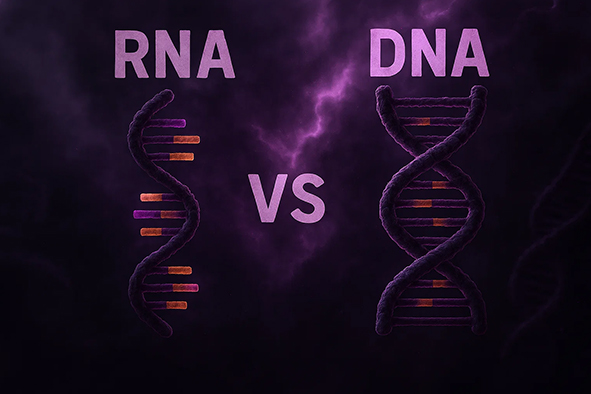Have you questioned how DNA differs from RNA beyond the definitions in textbooks? Such terms are standard in science documentaries, research articles, or health breakthroughs. But these terms can sound like buzzwords rather than tools that are changing the future of medicine unless you are into genetics or molecular biology. So, let’s break down the amazing world of RNA and DNA sequencing.
Let’s step back before getting into the nitty gritty of RNA and DNA sequences.
Table of Contents
ToggleWhat is DNA and RNA?
The RNA messenger has an important job. It moves from the nucleus to the cytoplasm, where proteins are synthesized and assisted via various organelles and cellular structures. It tells the body what to build or break down. It manages the processes of cell and tissue growth and assists in preparing the body for the work it must do.
Looking at scaling down, your body can be considered an intricate metropolitan city, where each voice within it helps keep all the functions in synchronization. In contrast, new traits and sometimes cities can be added through new instructions in the form of life; RNA serves as the messenger for these instructions. DNA refers to the several interconnected rivers that provide the overall plan for city development. They endlessly provide resources so they can be successfully built.
DNA Sequencing
As the name suggests, it encompasses determining the precise sequence of the four chemical bases (Adenine (A), Thymine (T), Cytosine (C), and Guanine (G)) of your DNA. That’s akin to interpreting recipes order by order.
Why do scientists do this? Because by reading your DNA, they can:
- Discover inherited disorders
- Track genetic mutations
- Understand why certain drugs work for some people and not others
In short, DNA Sequencing helps us look at the big picture of your genetic makeup.
RNA Sequencing
Now, let’s talk about RNA Sequencing. If DNA is the book, RNA is the script currently being read. RNA Sequencing analyzes data to give meaningful insight into relation, comparison, and a broader understanding of the entirety of an organism’s gene systems (individual to complex).
Why does that matter? Because RNA Sequencing is excellent at capturing real-time snapshots of activity in a cell. It’s perfect for understanding:
- How diseases like cancer behave
- How cells respond to treatments
- What’s going on in different tissues or during different life stages
Key Differences Between RNA & DNA Sequencing
So, let’s break it down clearly. What are the key differences b/w RNA & DNA sequencing?
| Feature | RNA Sequencing (RNA-seq) | DNA Sequencing |
| Target Molecule | Ribonucleic acid (RNA) | Deoxyribonucleic acid (DNA) |
| Purpose | To study gene expression and transcriptome profiling | To analyze the genome and identify genetic variations |
| Starting Material | RNA (usually mRNA) | Genomic DNA |
| Process Includes | Reverse transcription to cDNA before sequencing | Direct sequencing of DNA |
| What It Reveals | Which genes are active and to what extent | Complete genetic code and mutations |
| Application | Gene expression analysis, splicing variants, RNA editing | Whole genome/exome sequencing, mutation detection |
| Data Variability | Dynamic – changes based on time, condition and cell type | Static – DNA sequence remains the same in all cells |
| Read Coverage | Only transcribed regions (exons) | Entire genome (including introns and non-coding regions) |
| Challenges | RNA is less stable, more prone to degradation | DNA is comparatively stable and easier to work with |
Applications of RNA & DNA in Real Life
Let’s take it a step further. The applications of RNA & DNA have multiple uses other than science, medicine, and agriculture field.
In healthcare:
- DNA sequencing helps diagnose genetic conditions, guide personalized treatments, and understand rare diseases.
- RNA Sequencing helps analyze tumors, track immune response, and predict drug effectiveness.
In agriculture:
- DNA techniques are used to breed better crops.
- RNA studies help understand how plants respond to climate change or disease.
In research:
- DNA reveals genetic patterns across species.
- RNA shows how those patterns are expressed under different conditions.
In short, applications of RNA & DNA have changed the way we approach disease, evolution, and even our daily lives.
How Do Scientists Choose Between RNA and DNA Sequencing?
Everything depends on the particular issue at hand. A scientist interested in discovering whether a specific mutation exists in your genetic code will use DNA sequencing.
RNA sequencing gives them better insights if they’re trying to determine why a cell is acting up (like turning cancerous). So, the real magic happens when both are used together DNA for structure, RNA for function.
Wrapping Up!
When understanding life, health, and disease, RNA sequencing and DNA sequencing are like two sides of the same coin. You can’t fully appreciate one without the other. The key differences b/w RNA & DNA aren’t about which is better they’re about what they reveal. DNA tells us what’s written.
RNA tells us what’s read. Whether you’re diving into the world of genomics, curious about how genetic testing works, or want to understand your body better knowing the applications of RNA & DNA is like unlocking a new level of understanding.




